THE majestic buffalo produces a fine drop of milk, according to mid North Coast farmers Ian and Kim Massingham. Boasting a fat content of 8%, the creamy milk fetches a retail price of $8 per litre at the Massinghams’ farm cafe and up to $3.50 per litre when sold to specialty cheesemakers.
The downside is production peaks at around 8 litres per cow per day, compared to up to 30 litres per day for a Holstein-Friesian. But lower yields are not a concern for Ian and Kim, whose main focus is their cafe and producing value-added niche products.
Ian says it was a failed search for buffalo mozzarella in Sydney more than a decade ago that inspired a momentous lifestyle change.
“We ventured to Italy about 11 years ago and discovered the wonders of buffalo mozzarella.” – Ian Massingham
“Buffalo mozzarella and farming is ingrained into the southern Italian culture with lots of small and large farms. We thought we would just start buying it when we got back to Australia.”
An extensive culinary search upon returning to Sydney led nowhere, so Ian and Kim decided to get their own buffalo milking cow for their 10-hectare property at East Kurrajong, north-west of Sydney. That soon led to the purchase of another 10 cows from Victoria, the construction of a small cheesemaking facility and some market research into demand for their homemade mozzarella di bufala.
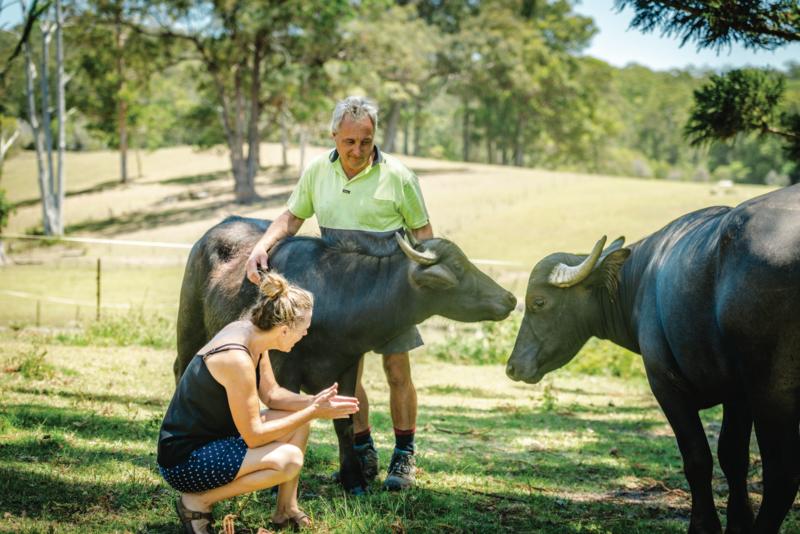 Ian and Kim Massingham interacting with young buffalo on their Eungai farm.
Ian and Kim Massingham interacting with young buffalo on their Eungai farm.
“We were working during the day, making cheeses at night and then doing markets on the weekends,” Ian says. “It started to get too much for us and we decided it was time for a lifestyle change.”
The search for a suitable farm began and resulted in them buying a 120-hectare biodynamic farm at Eungai near Macksville on the North Coast seven years ago.
RELATED:
Reaping the rewards of biodynamic farming
The Massinghams now have 100 head of buffalo, an
on-farm processing facility and a cafe, and they operate one of only two buffalo dairies in NSW.
Kim is chief cheesemaker and churns out mozzarella, feta, pecorino, haloumi, Persian feta, havarti, parmesan and quark, as well as gelato, yoghurt and labna. Their products are sold through the cafe, at local farmers’ markets and direct to a few restaurants.
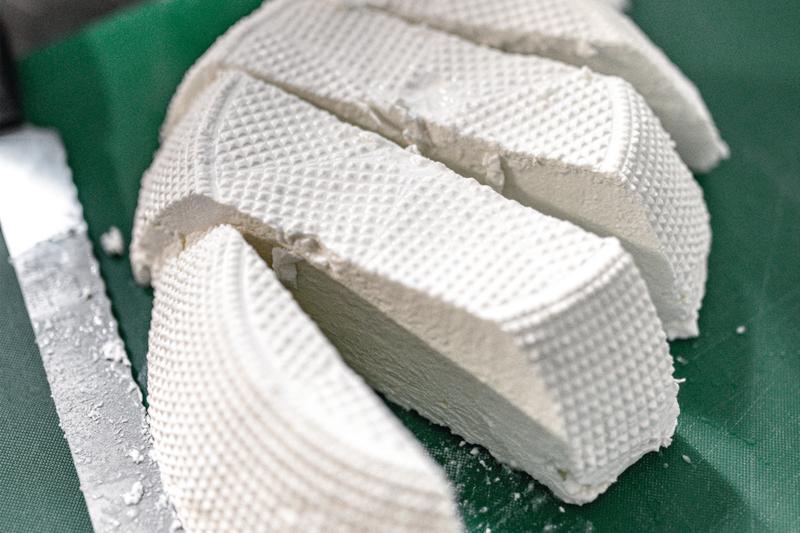 Kim and Ian’s buffalo feta.
Kim and Ian’s buffalo feta.
“It has been a steep learning curve. Cheesemaking recipes are completely different with buffalo milk because of the higher fat content and different protein structure.” – Kim Massingham
“It is best for making soft cheeses. The high fat content and creaminess also make it ideal for yoghurt and gelato.”
Like the milk of its dairy cousins, buffalo milk is free of additives and preservatives that Kim says are found in commercial soy and nut ‘milks’.
RELATED:
Milk wars: farmers take on dairy alternatives
“Our customers love our buffalo milk coffees and it makes a good milkshake,” she says.
The coffee served at the cafe is sourced locally, as is the native produce such as finger limes, macadamias and lemon myrtle used to flavour the thick and creamy gelato.
 Rose Durn serving buffalo-milk gelato at the Massingham's farm shop.
Rose Durn serving buffalo-milk gelato at the Massingham's farm shop.
“The popularity of Australian buffalo cheese has not had its day yet,” says
Australian Buffalo Industry Council president Mitch Humphries, a former conventional dairy farmer who milks about 300 buffalo cows in North Queensland and Victoria.
“Mozzarella, blue cheese, ricotta, feta and haloumi are all becoming more and more in demand. Different ethnic groups in cities make their own products and there are even sweets being made from buffalo milk.”
Unlike a conventional dairy, Ian says they leave the calves on the buffalo cows and only milk in the mornings, and not every day.
“Because we are calving in March/April, peak production for us is in the winter months.”
“Buffalo milk is a small-globule milk like sheep milk, so you can freeze it and bring it out to make gelato when milk production is down.” – Ian Massingham
“Because we don’t milk every day, the cows would only average three to four litres per day, but they can produce up to nine litres per day.”
Ian says the farm had been biodynamic for 40 years before being transformed into a buffalo haven.
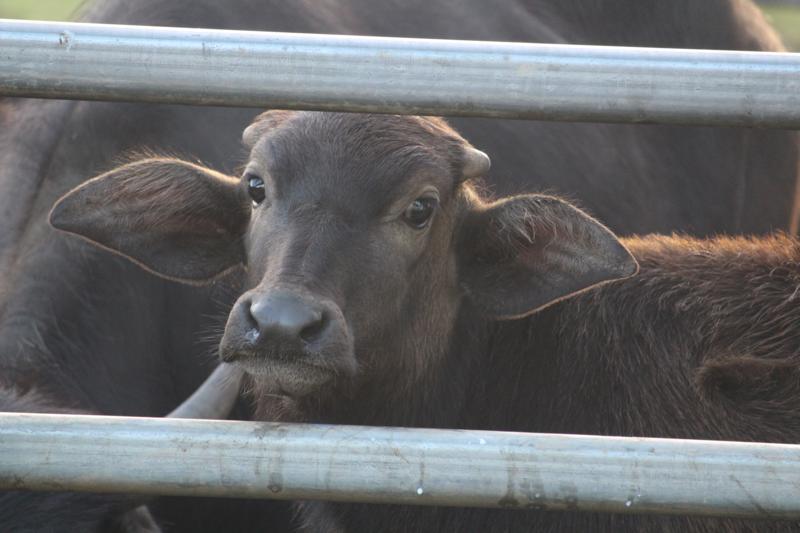 Buffalo calves are left with their mothers, unlike cows.
Buffalo calves are left with their mothers, unlike cows.
“We have kept a lot of the biodynamic practices going, but the farm is not certified because we buy in feed. We have had a bad run of weather in the past two years, so our feed bill is quite astronomical for a small farm.”
Grazing improved pastures is supplemented with a daily mixture of 17% protein pellets, lucerne chaff and grass hay.
RELATED:
The drought hay crisis
“I bought my own bailer and make hay from our subtropical grasses such as paspalum and setaria,” says Ian.
“Buffalo seem to convert roughage and poorer-quality feeds better than cattle.” – Ian Massingham
Little input is needed for animal health management. Buffalo have an inherent resistance to ticks and worms, and an organic oil product called Cattle Coat is applied to assist with buffalo fly control. Buffalo are part of the National Livestock Identification System and the farm’s food safety requirements are the same as for conventional dairy farmers.
RELATED:
What’s bugging our biosecurity experts?
Ian used his welding and engineering skills to modify the small existing dairy, set up the processing equipment and build a cafe with an outdoor dining area overlooking the farm and buffalo herd.
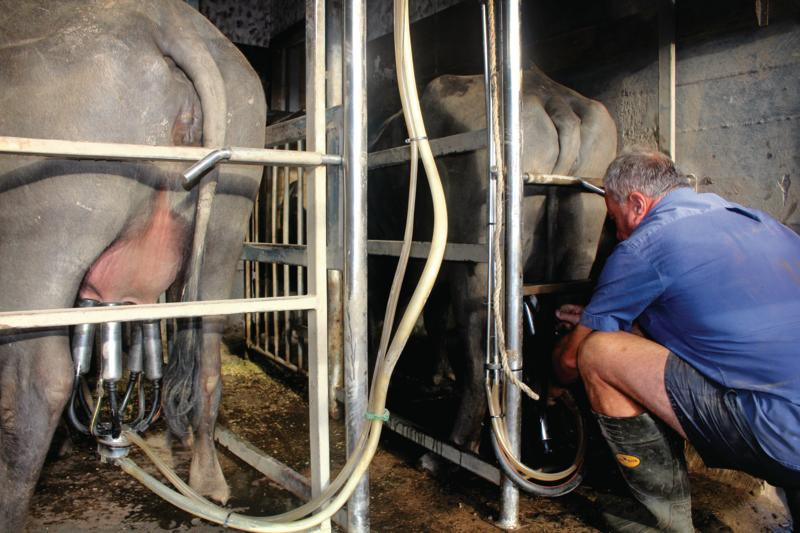 Ian milking the buffalo cows in the dairy he engineered and welded himself.
Ian milking the buffalo cows in the dairy he engineered and welded himself.
Buffalo meat features on the cafe menu in dishes including lasagne, curries, burgers, buffo bucco, Nepalese dumplings, ‘buff and bacon’ pizzas and chorizo sausages made with buffalo and pork.
“We go through one carcase about every two weeks. They are processed at 18 months to two years old at a live weight of around 450kg and we get about a 50% carcase yield,” Ian explains.
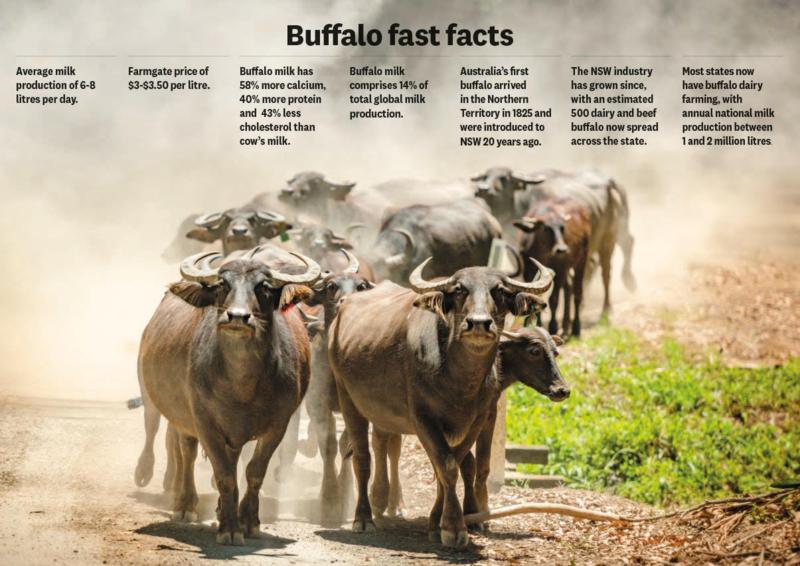
The farm has become quite a tourist attraction on the North Coast food trail. Tour groups and locals alike are happy to make the gravel-road journey for a buffalo-inspired lunch or pizza night. The cafe and farm and are open to the public from Wednesday to Sunday from 10am to 3pm for lunch or just a visit, and on Friday and Saturday nights for dinner.
RELATED:
Winery focuses on exports and a stronger cellar door
Ian says they had no previous experience in the farming sector and have faced a number of challenges, including drought, and they have a new-found admiration for farmers.
“We had a German backpacker here for five months and he said ‘Your cup is always half full, Ian’. I thought that was an apt description of farming. There is always something to do and you have to be an engineer, an agronomist, a mechanic and marketer as well as a farmer.”
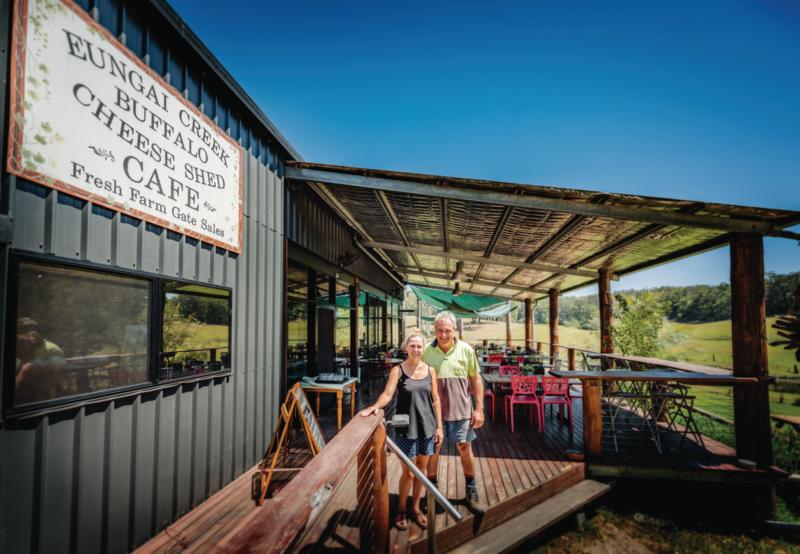 Ian and Kim on the deck of their farmgate cafe
Ian and Kim on the deck of their farmgate cafe
Top four tips for a happy buffalo herd
- Buffalo are easy to handle as long as they are worked with on a regular basis.
- It is recommended buffalo have access to good shade, and shelter from heat in summer and cold in winter, using effective tree and shelterbelts or shade structures.
- Electric fencing is recommended in paddocks.
- Buffalo need to be handled firmly but very gently. Handling affects the tenderness and quality of the meat. Calm animals produce more tender meat.
Source: Australian Buffalo Industry Council